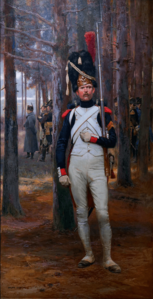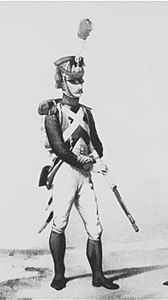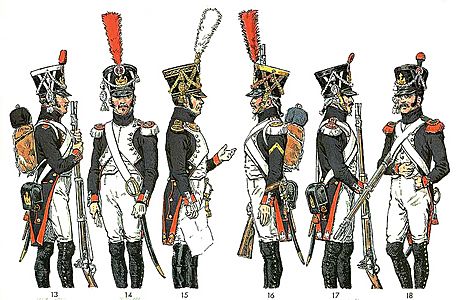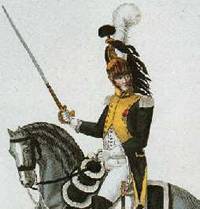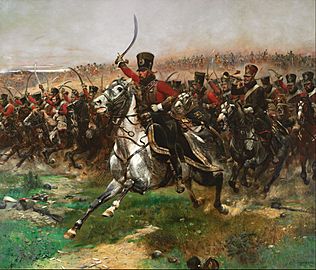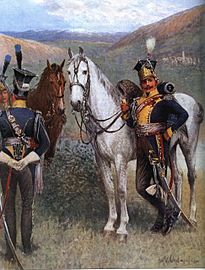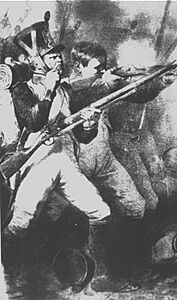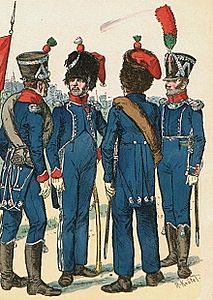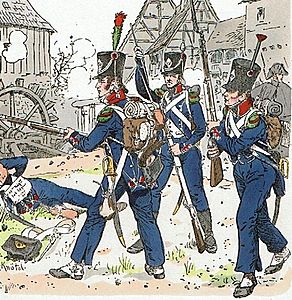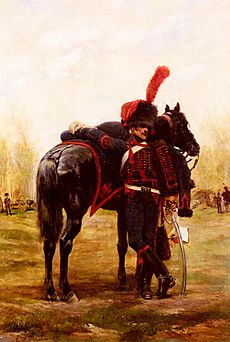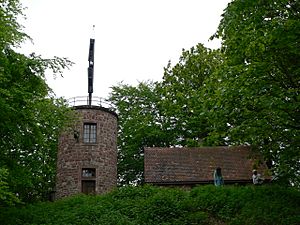Grande Armée facts for kids
The Great Army (in French, La Grande Armée) was the main army of Emperor Napoleon Bonaparte during the Napoleonic Wars. From 1804 to 1808, this army won many battles. These victories helped the French Empire control most of Europe.
The Great Army was known as one of the best fighting forces ever. But it faced huge losses during the terrible invasion of Russia in 1812. After this, it never fully got back its strength. The term Grande Armée is often used to describe all the different armies Napoleon gathered for his campaigns.
Contents
Napoleon's Great Army
The Great Army was special for its new ways of fighting. It had clever formations, tactics, and ways to get supplies. Most of its groups were led by French generals. But soldiers could move up in rank no matter their background or where they came from.
When it first started, the Great Army had six main groups called corps. These were led by Napoleon's top generals. In 1805, Austria and Russia planned to attack France. Napoleon quickly moved his army across the Rhine River into Germany. This led to his big wins at Ulm and Austerlitz.
As Napoleon gained more power in Europe, his army grew. He recruited soldiers from countries he had taken over or allied with. In 1812, at its largest, the Great Army had over 600,000 men. About 413,000 of these were French soldiers.
The Russian Campaign
In the summer of 1812, the Great Army marched east into Russia. The Russian army kept falling back. After capturing Smolensk and winning at Borodino, the French reached Moscow on September 14, 1812.
However, the army was already much smaller. Many soldiers were lost due to small fights, sickness (like typhus), and leaving the army. The heat and long supply lines also caused problems. The army stayed in Moscow for a month. But they were forced to march back west.
The cold, hunger, and sickness destroyed the Great Army as a fighting force. Russian fighters also attacked them constantly. Only about 120,000 men made it out of Russia. Most of these were non-French soldiers. Only about 35,000 were French. Around 380,000 soldiers died in this campaign.
Napoleon led new armies in 1813, 1814, and 1815. But the Great Army never became as strong as it was in June 1812. From 1805 to 1813, over 2.1 million Frenchmen joined the French Imperial Army.
Army Organization
One key reason for the Great Army's success was its smart and flexible organization. It was split into several corps. Each corps had between 10,000 and 50,000 soldiers. The average size was about 20,000 to 30,000 troops.
These corps were like smaller, self-contained armies. They had all types of soldiers and support services. They could fight on their own or defend themselves until help arrived. Corps usually worked closely together. They stayed within a day's march of each other. This allowed them to move quickly and surprise enemies.
Napoleon trusted his corps commanders. He usually let them make their own decisions. But they had to follow his main goals and work together. If they failed, he would take over their command himself. Corps were first used in 1800. Napoleon made them permanent units in 1804. Sometimes, he would form cavalry into separate corps. This let them move faster without being slowed by foot soldiers.
The main fighting units within a corps were the divisions. These usually had 4,000 to 10,000 foot soldiers or 2,000 to 4,000 cavalrymen. Divisions were made of two or three brigades. Each brigade had two regiments. They also had an artillery brigade with three or four batteries. Each battery had six field cannons and two howitzers. This meant 24 to 32 guns in total.
Special Units of the Great Army
Imperial Guard
The Imperial Guard was one of the best military forces of its time. It grew from earlier guard units. It was a single corps with infantry, cavalry, and artillery. The Guard had its own special uniforms and identity. Napoleon wanted it to be an example for the whole army. Its soldiers were very loyal to him. The Guard's cavalry and artillery were often used to deliver the final blow in battles.
| Year | Number of soldiers |
|---|---|
| 1800 | 3,000 |
| 1804 | 8,000 |
| 1805 | 12,000 |
| 1810 | 56,000 |
| 1812 | 112,000 |
| 1813 | 85,000 (mostly Young Guards) |
| 1815 | 28,000 |
Guard Infantry
The Guard infantry had three main parts:
- Old Guard: These were the most experienced soldiers. They were the best of the best.
- Imperial Guard Foot Grenadiers: The Grenadiers were the most senior regiment. Napoleon called them Les Grognards (The Grumblers) in 1807. They were very brave and experienced. To join, a soldier needed at least 10 years of service and a bravery award. They wore dark blue coats with red trim and tall bearskin hats.
- Imperial Guard Foot Chasseurs: These were the second most senior regiment. They had similar entry rules to the Grenadiers. They also wore dark blue coats and tall bearskin hats.
- Middle Guard: These soldiers were veterans of at least three campaigns.
- Fusiliers-Chasseurs and Fusiliers-Grenadiers: These were formed in 1806 and 1807. They were excellent infantry. They often fought together.
- Marines of the Guard: Formed in 1803, these soldiers were meant to man Napoleon's ship. They also fought as combat units. They wore unique hussar-style uniforms.
- Young Guard: This group was made of veterans with at least one campaign. It also included bright young officers and the best new recruits.
- Tirailleurs-Grenadiers and Tirailleurs-Chasseurs: These were the first Young Guard regiments. Officers came from the Old Guard, and NCOs from the Middle Guard. This helped train the new soldiers.
Guard Cavalry
The Guard Cavalry was made of several elite regiments.
- Imperial Guard Horse Grenadiers: Known as the Gods or Giants, these were the best of Napoleon's cavalry. They wore tall bearskin caps and dark blue coats. They were never defeated in battle.
- Imperial Guard Horse Chasseurs: Called the Favoured Children, these were the light cavalry of the Guard. Napoleon often wore their uniform. They were known for their colorful uniforms.
- Elite Gendarmes: These were the military police of the Great Army. They kept order and protected Napoleon's belongings. They rarely fought but were very important.
- Squadron of Mamelukes: These were fierce desert warriors from Egypt. They were excellent horsemen and very brave. They wore colorful uniforms with turbans and baggy trousers.
- Lancers of the Guard:
- 1st Light Horse Regiment (Polish): These Polish lancers were very feared. They were known for their bravery at Somosierra. Napoleon called them his "bravest cavalry." They were never beaten by enemy cavalry.
- 2nd Light Horse Regiment (French-Dutch): Known as Les Lanciers Rouges (the Red Lancers) because of their uniforms. They fought well in many battles, including Waterloo.
- Empress Dragoons: Formed in 1806, these dragoons were named after Empress Joséphine. They were a ceremonial unit but also fought with the emperor until the end.
- Scouts of the Imperial Guard: Created in 1813, these cavalry units were inspired by the Cossacks. They were used for scouting and quick attacks.
-
French 4th Hussars at the Battle of Friedland
-
Hat of a soldier of the 17th Lithuanian Uhlan Regiment with Vytis
Infantry Soldiers
Infantry soldiers did most of the fighting. They were divided into two main types: Line Infantry and Light Infantry.
Line Infantry
The line infantry made up most of the Great Army. A line infantry battalion usually had 400–600 men. From 1808 to 1815, a battalion had four companies of fusiliers, one company of grenadiers, and one company of voltigeurs.
- Grenadiers: These were the elite of the line infantry. They were strong, brave, and tall. They wore bearskin hats or shakos with red plumes. They also carried a short sabre for close combat.
- Voltigeurs: These were elite light infantry. They were the smallest and most agile men. They were good at shooting and moving quickly. They acted as scouts and skirmishers. They wore shakos with yellow and green plumes.
- Fusiliers: These were the most common infantry soldiers. They were armed with a smoothbore musket and a bayonet. They were trained for fast marches and close-range fighting. They wore dark blue coats and white trousers. Their hats had colored pom-poms to show their company.
Light Infantry
The Light Infantry (Infanterie Légère) also played an important role. They were fewer in number than the line infantry. But they were trained for faster movement and better shooting. They were often used to screen large army movements.
- Carabiniers-à-Pied: These were the elite of the light infantry. They were like the grenadiers of the line infantry. They wore bearskin caps or red-trimmed shakos.
- Light Voltigeurs: These were similar to line voltigeurs but even more agile. They were dressed as chasseurs but with yellow and green epaulettes.
- Chasseurs: These were the main soldiers of the light infantry. They were armed with muskets and bayonets. They had more ornate uniforms than fusiliers. They wore dark green coats and shakos with green plumes.
Cavalry Soldiers
Cavalry made up about one-fifth to one-sixth of the Great Army. Napoleon improved the cavalry greatly. It became one of the best in the world. There were two main types: heavy cavalry and light cavalry.
Heavy Cavalry
- Carabiniers-à-Cheval: These were the elite heavy cavalry. They wore helmets and breastplates covered in bronze. They were used for powerful charges.
- Cuirassiers: These heavy cavalry wore metal breastplates and helmets. They were like medieval knights. They used long, straight sabers. They were very strong in a charge. Napoleon often used them as a reserve force to win battles.
- Dragoons: These were medium-weight cavalry. They were used for fighting, skirmishing, and scouting. They carried swords and muskets. They could fight on foot or horseback.
Light Cavalry
- Hussars: These were fast, light cavalrymen. They were the "eyes and ears" of the army. They were used for scouting and chasing enemies. They were known for their brave and reckless style. They wore colorful uniforms.
- Chasseurs à Cheval: These were light cavalry similar to hussars. They were also used for scouting and skirmishing. They were the most common light cavalry.
- Lancers: Some of the most feared cavalry were the Polish lancers. They carried lances, sabers, and pistols. They were fast and had strong charging power. They were very effective against infantry squares.

Artillery
Napoleon was once an artillery officer. He believed "God fights on the side with the best artillery." French cannons were very important to the Great Army. They had the most firepower and could cause the most damage quickly.
French guns were often used in large groups called grandes batteries. These would weaken enemy formations before infantry or cavalry attacked. French artillery was also improved by Jean Baptiste de Gribeauval. He made cannons lighter and easier to aim.
There were two main types of artillery: Artillerie à pied (foot artillery) and Artillerie à cheval (horse artillery).
- Foot Artillery: These gunners marched with their cannons. The guns were pulled by horses when moving. They moved at the pace of the infantry. Each division and corps had its own artillery.
- Horse Artillery: These were fast-moving, fast-firing light guns. Their crews rode horses or on the gun carriages. They could move quickly, set up, fire, and move again. They were the best trained artillerymen. They were very expensive to keep, so there were fewer of them.
Ammunition
The main type of ammunition was the round shot. This was a heavy iron ball. It could be very deadly even at long range. For close-range fighting, Grapeshot and canister were used. These spread out like a shotgun blast. They were very effective against groups of soldiers.
For longer range, shells were used. These were hollow spheres filled with gunpowder. They exploded in the air over the enemy.
Artillery Train
The train d'artillerie was created in 1800. Its job was to provide the drivers and horses for the artillery. Before this, civilian drivers were used. They sometimes left the guns behind in battle. The new military drivers were armed and trained. They were known for being tough and ready to fight.

Foreign Troops
Many European armies had foreign soldiers. The Great Army was no different. Soldiers from almost every European country fought in it. By the end of the wars, tens of thousands had served.
In 1812, over one-third of the troops marching into Russia were not French. They came from 20 different countries. These included Austria and Prussia.
Support Services
Engineers
Engineers were very important to the army. They built bridges and dealt with enemy defenses.
- Pontonniers: These were bridge builders. They helped the army cross rivers quickly. They could build a bridge over a wide river in just a few hours. This skill saved the army from being destroyed during the retreat from Moscow.
- Sappers: These engineers dealt with enemy forts. But Napoleon often chose to go around forts instead of attacking them directly. So sappers often did other tasks.
The engineer companies were called Génie. This was a slang term for engineer. It also meant "genie" because of their amazing ability to make things happen.
Logistics and Supplies
Napoleon famously said, "An army is a creature which marches on its stomach." This means getting food and supplies was very important. Soldiers carried four days' worth of food. Supply wagons carried eight days' worth.
Napoleon encouraged his men to find food from the land. This was called La Maraude. Women called cantinières (or vivandières) also followed the army. They were married to soldiers and sold food and drink. They were vital when other supplies ran out.
Napoleon also set up supply bases and depots. These would move forward as the army advanced. This system helped the Great Army march up to 15 miles a day for weeks. A new way to preserve food, called canning, also helped.
Medical Service
The medical services dealt with the terrible results of war. While medicine itself didn't change much, the way it was organized did. The French Army created the first modern ambulance and triage systems.
Dominique Jean Larrey developed ambulances volantes (flying ambulances). These were fast units that followed the army. They gave first aid and quickly moved badly wounded soldiers away from the battlefield. Each team had a doctor, a quartermaster, a non-commissioned officer, a drummer boy (who carried bandages), and 24 stretcher bearers.
Another surgeon, Baron L.P. Percy, created a system for trained stretcher bearers. They would carry wounded soldiers to where surgeons were. Every French unit had its own medical staff. Larrey also made military hospitals more mobile.
These improvements meant soldiers knew they would be cared for. This helped boost morale. Larrey also treated wounded soldiers from both sides of the battle. This idea is now part of the Geneva Conventions.
Despite these efforts, conditions were still very basic. More soldiers died from wounds or sickness than in battle. There was little knowledge of hygiene or antibiotics. The main surgery was amputation. Strong alcohol was often the only painkiller.
Napoleon made sure that soldiers who survived were well cared for back home. They received medals, pensions, and prosthetic limbs if needed.
Communications
Most messages were sent by messengers on horseback. Hussars were often chosen for this job because they were brave and good riders. Shorter messages were sent using flags, drums, or trumpets.
The Great Army also used new communication methods. They used homing pigeons and observation balloons. But the biggest advance was the semaphore system invented by Claude Chappe.
Chappe's system used a network of towers. Each tower had large, movable wooden rods. These rods could form different "signs." A message could travel from Paris to Lille (193 km) in just 9 minutes. Napoleon used this system to coordinate his forces faster than his enemies.
Fighting Styles and Tactics
Napoleon was a master of strategy and tactics. He combined old fighting methods with new ones. Unlike many enemies, the Great Army used flexible formations. Other armies often used rigid "Linear" tactics. They would line up and fire at each other.
Napoleon often pretended to attack the enemy's sides. Then he would attack their center, breaking their lines. He always kept a strong reserve, like his Imperial Guard. This force could deliver a final blow or turn the battle around.
Here are some famous tactics used by the Great Army:
- Line: Soldiers formed a three-rank line. This was good for firing volleys and fighting hand-to-hand. But it was slow and weak on the sides.
- March Column: This was best for moving troops quickly. It was also good for attacking hand-to-hand. But it had little firepower and was weak to attacks from the sides.
- Wedge: A V-shaped cavalry formation. It was designed to break enemy lines.
- Attack Column: A wide column of infantry. Light infantry skirmishers would go first to confuse the enemy. Then the column would fire and charge with bayonets. This was good against thin enemy lines.
- Mixed Order: Napoleon's favorite infantry formation. Some units were in line, others in attack column. This combined the firepower of the line with the speed of the column.
- Open Order: Soldiers spread out. This was good for light troops and skirmishers. It allowed fast movement and protection from enemy fire. But it was bad for massed firing or close combat.
- Square: A classic infantry formation for defense against cavalry. Soldiers formed a hollow square. This protected them from charges. But squares were slow and vulnerable to artillery.
- Flying Battery: Artillery would move quickly, fire, and then move to a new spot. This allowed Napoleon to focus fire where it was needed. Horse artillery was especially good at this.
- Grand Battery: Many cannons would gather and fire at one key point. This could be devastating if the enemy was surprised. But it was hard to hide.
Ranks of the Great Army
Maréchal d'Empire, or Marshal of the Empire, was not a rank. It was a special title given to skilled generals. The highest permanent rank was Général de division (Major General).
-
-
-
-
-
-
-
Grande Armée ranks Modern U.S./U.K./NATO equivalent Général de division,
Lieutenant général (Ancien Régime rank reintroduced in 1814)Major general Général de brigade,
Maréchal de camp (Ancien Régime rank reintroduced in 1814, equivalent of major general)Brigadier general Adjudant-commandant Staff colonel Colonel Colonel Colonel en second Senior lieutenant colonel Major Lieutenant colonel Major en second Senior major Chef de bataillon or Chef d'escadron Major Capitaine adjutant-major Staff captain Capitaine Captain Lieutenant First lieutenant Sous-lieutenant Second lieutenant Non-commissioned officers Adjudant sous-officier Chief warrant officer Adjudant-Chef Warrant officer Adjudant Sergeant-major Sergent-Major or Maréchal des logis Chef First sergeant Sergent or Maréchal des Logis Sergeant Caporal-Fourrier or Brigadier-Fourrier Company clerk/supply sergeant Caporal or Brigadier (cavalry, horse artillery and Gendarmerie) Corporal Soldat or Cavalier (cavalry) or Canonnier (artillery) Private
-
-
-
-
-
-
Images for kids
-
Charles Joseph Minard's famous graph showing the decreasing size of the Grande Armée as it marches to Moscow (brown line, from left to right) and back (black line, from right to left) with the size of the army equal to the width of the line. Temperature is plotted on the lower graph for the return journey.
See also
- Spanish Army (Peninsular War)
- British Army during the Napoleonic Wars
- French Imperial Eagle
- Legion of Honour
- List of French general officers (Peninsular War)
- Types of military forces in the Napoleonic Wars
- Uniforms of La Grande Armée
- Weapons of Honour
- Social background of officers and other ranks in the French Army, 1750–1815



